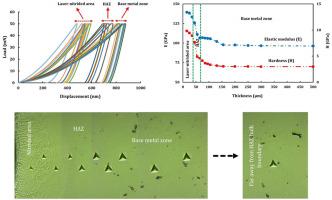Journal of the Mechanical Behavior of Biomedical Materials ( IF 3.3 ) Pub Date : 2021-08-27 , DOI: 10.1016/j.jmbbm.2021.104802 Hadi Asgharzadeh Shirazi 1 , Chi-Wai Chan 2 , Seunghwan Lee 1

|
Laser nitriding is one of the most promising approaches to improve wear resistance of Ti alloy surfaces and may extend the use in orthopaedic implants. In this study, three types of Ti alloys, namely alpha commercially pure Ti (“TiG2”), alpha-beta Ti–6Al–4V (“TiG5”), and beta Ti-35.5Nb-7.3Zr-5.7Ta (“βTi”), were subjected to an open-air laser nitriding treatment. Essential elastic-plastic mechanical properties including elastic modulus, hardness, elastic energy, plasticity index, and hardness-to-elasticity ratio of the laser-treated Ti alloys were characterized using nanoindentation experiment. The results showed that the elastic modulus, hardness and elastic energy values of all Ti samples significantly increased in the nitrided layer compared to respective bare substrates for all three Ti materials. Across different Ti samples, βTi sustained its relatively lower elastic modulus, but presented comparable hardness, elastic energy, plasticity index, as well as hardness-to-elasticity ratio in the nitrided layer compared to the other two Ti alloys. Overall, amongst three medical grade Ti alloys in this study, βTi appeared as the most appealing candidate for joint replacement applications even solely in view of mechanical compatibility when combined with surface laser nitriding. Nevertheless, laser nitriding treatment in this study tended to cause a residual compressive stress on all Ti alloys as displayed by cracks developed in the nitrided layer and analyzed on βTi by X-ray diffraction (XRD) and further nanoindentation tests.
中文翻译:

用于骨科植入物的光纤激光表面氮化改性钛及其合金的弹塑性性能
激光渗氮是提高钛合金表面耐磨性的最有前途的方法之一,可能会扩大在骨科植入物中的应用。在本研究中,三种类型的钛合金,即 α 商业纯钛 (“TiG2”)、α-β Ti-6Al-4V (“TiG5”) 和β Ti-35.5Nb-7.3Zr-5.7Ta (“βTi”) ”),进行了露天激光氮化处理。采用纳米压痕实验表征激光处理钛合金的弹性模量、硬度、弹性能、塑性指数和硬弹比等基本弹塑性力学性能。结果表明,与所有三种钛材料的各自裸基体相比,所有钛样品的弹性模量、硬度和弹性能值在氮化层中均显着增加。在不同的 Ti 样品中,βTi 维持其相对较低的弹性模量,但与其他两种 Ti 合金相比,氮化层的硬度、弹性能、塑性指数以及硬度与弹性比具有可比性。总体而言,在本研究中的三种医用级钛合金中,βTi 似乎是关节置换应用中最具吸引力的候选材料,即使仅考虑与表面激光渗氮结合使用时的机械兼容性。然而,本研究中的激光渗氮处理倾向于在所有 Ti 合金上产生残余压应力,如渗氮层中产生的裂纹所示,并通过 X 射线衍射 (XRD) 和进一步的纳米压痕测试对 βTi 进行分析。以及与其他两种钛合金相比,氮化层的硬度与弹性比。总体而言,在本研究中的三种医用级钛合金中,βTi 似乎是关节置换应用中最具吸引力的候选材料,即使仅考虑与表面激光渗氮结合使用时的机械兼容性。然而,本研究中的激光渗氮处理倾向于在所有 Ti 合金上产生残余压应力,如渗氮层中产生的裂纹所示,并通过 X 射线衍射 (XRD) 和进一步的纳米压痕测试对 βTi 进行分析。以及与其他两种钛合金相比,氮化层的硬度与弹性比。总体而言,在本研究中的三种医用级钛合金中,βTi 似乎是关节置换应用中最具吸引力的候选材料,即使仅考虑与表面激光渗氮结合使用时的机械兼容性。然而,本研究中的激光渗氮处理倾向于在所有 Ti 合金上产生残余压应力,如渗氮层中产生的裂纹所示,并通过 X 射线衍射 (XRD) 和进一步的纳米压痕测试对 βTi 进行分析。βTi 似乎是关节置换应用中最具吸引力的候选材料,即使仅考虑到与表面激光渗氮结合使用时的机械兼容性。然而,本研究中的激光渗氮处理倾向于在所有 Ti 合金上产生残余压应力,如渗氮层中产生的裂纹所示,并通过 X 射线衍射 (XRD) 和进一步的纳米压痕测试对 βTi 进行分析。βTi 似乎是关节置换应用中最具吸引力的候选材料,即使仅考虑到与表面激光渗氮结合使用时的机械兼容性。然而,本研究中的激光渗氮处理倾向于在所有 Ti 合金上产生残余压应力,如渗氮层中产生的裂纹所示,并通过 X 射线衍射 (XRD) 和进一步的纳米压痕测试对 βTi 进行分析。











































 京公网安备 11010802027423号
京公网安备 11010802027423号